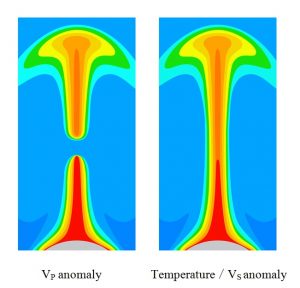
The composition and temperature of the Earth’s interior are fundamental for understanding the Earth’s interior and dynamics. Because it’s impossible to directly access most areas of the Earth’s interior, the combination of the elasticity of minerals at high pressure and temperature (PT) and seismic results is one of most practical ways to constrain the temperature and chemical composition of Earth’s interior. This is done by determining what kinds of mineral aggregates have the same sound velocities and densities as Earth’s interior.
Therefore, the elasticity of minerals at high PT is crucial for translating the seismic sound velocity into composition and temperature. However, obtaining elasticity of minerals at high PT is highly challenging for experimental measurements and extremely expensive using the first-principles calculations. Wu and Wentzcovitch (2011) developed a new method, which reduces the computational loads to one-tenth of the traditional method.
The method has been successfully applied to many minerals whose elastic data are ideal in constraining the composition and temperature and understanding the velocity structure of the lower mantle. Zhongqing Wu and Wenzhong Wang, two scientists at University of Science and Technology of China, recently reviewed this technique.
The traditional method requires vibration density of state (DOS) of ~ 100 configurations with various kinds of strains and volumes. By analyzing the relations between volume dependence and strain dependence of lattice vibration, Wu found how to obtain the strain dependence of lattice vibration needed to calculate the elasticity from the volume dependence of vibration, which avoids the vibration DOS for the configurations under strain.
Therefore, the number of the vibrational DOS that need to be calculated is reduced to ~10 from ~100 in the traditional method. It is clear that the computational and manual loads of the new method are less than one tenth those of the traditional method. The elastic data show that the new method has precision comparable to the traditional method.
The effect of iron spin transition on the properties of ferropericalse has been conducted extensively in the last decade. Taking advantage of the new method, the researchers for the first time obtained the elastic data of ferropericlase and found that the spin transition can produce some visible features in seismic tomography and some reported seismic tomography results show features consistent with the spin crossover. This opens the possibility to take direct advantage of the spin crossover to advance our understanding of the lower mantle.
In general, the bulk modulus of the materials decreases slowly with increasing temperature. The spin transition leads to an unusual effect: The bulk modulus of ferropericlase increases quickly with increasing temperature in a certain temperature range. The effect is so significant that the bulk modulus of the lower mantle can increase with increasing temperature at some depths—even the lower mantle has only ~15 wt% Fp.
Therefore, the temperature effect of the bulk modulus and of the shear modulus of the lower mantle cancel out and the VP of the lower mantle becomes insensitive to the temperature at a certain range of depths (~1750 km). VP anomaly caused by thermal anomaly should be much smaller at a depth of ~1750 km than those at the adjoined depths. The structure of VP appears to have a disruption (Figure 1). Geodynamic simulation shows that spin transition plays a critical role for structure feature of the large low shear velocity provinces in the lower mantle due to the anomalous effect of spin transition on the thermodynamic properties of ferropericalse. Therefore, the spin transition of iron in ferropericalse in the lower mantle has been suggested by three main branches of geophysics: mineral physics, seismology and geodynamics.
Using the obtained elastic data, Wu constrained the composition of the lower mantle and showed that (1) the content of Fp locates between the pyrolite and chondritic model, two main composition models of the mantle and (2) any composition well constrained by the seismic model has a sufficient amount of ferropericalse to show the positive temperature dependence of the bulk sound velocity but is not sufficient to exhibit the positive temperature dependence of the compressional wave velocity at the middle lower mantle. Anticorrelation between the bulk sound velocity and the shear velocity without involving any composition variation is a robust feature at the middle lower mantle.
Reference:
ZhongQing Wu et al, First-principles calculations of elasticity of minerals at high temperature and pressure, Science China Earth Sciences (2016). DOI: 10.1007/s11430-016-5296-6
Note: The above post is reprinted from materials provided by Science China Press.










